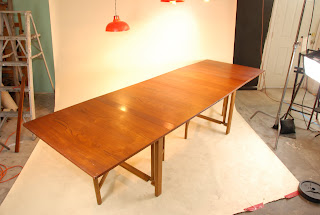I have always had a love for nature. Especially the lush green forests we used to hike through out east. This love for nature and my desire to protect and enhance it led me to an undergraduate degree in natural resources and a graduate in architecture. For the past eight years working as an architect, I have become more and more concerned with how disposable our society has become. This is especially true with contemporary furniture. Most manufactures are constructing pieces that will last 2-8 years before they simply fall apart. For two years now I have been doing my best to interrupt the process of throwing out some of the finest, handmade pieces of the 20th century because of finish issues or damage, for mass produced, low quality, and cheaply made furniture.
Although I thoroughly enjoy what I do with retrograde, I've gotten the design 'itch' and have begun to expand the sustainability mission. I am now designing and construction a line of furniture made from 100% reclaimed Mahogany and Teak. One of the first pieces is pictured below. Look for further posts coming soon that will describe the process in detail.
Why buy sustainable furniture??
Wood Waste:
The California Integrated Waste Management Board estimates that wood waste from construction and demolition represent 28% of the municipal waste stream every year.
Deforestation:
Scientists estimate that we are losing more than 137 species of plants and animals every single day because of rainforest deforestation.
Logging tropical hardwoods like teak, mahogany, rosewood, and other timber for furniture and other wood products is unsustainable and energy intensive.
Pollution:
According to the New York Times, a single cargo ship coming into a harbor can expel as much toxic emissions as 350,000 current-model automobiles in one hour.
According to the New York Times, a single cargo ship coming into a harbor can expel as much toxic emissions as 350,000 current-model automobiles in one hour.
Over the past 15 years, as international trade has exploded and shipping capacity has grown by 50 percent, cargo ships have become one of the nation's leading sources of air pollution, threatening the health of millions of people living in port cities such as Los Angeles. Made by hand in Long Beach. Local, domestic manufacturing has a far lighter impact on the environment than foreign imports.
Indoor Air Pollution:
Indoor air is three times more polluted than outdoor air, and according to the EPA, is considered to be one of the top 5 hazards to human health. Paints and finishes are among the leading causes.
Indoor air is three times more polluted than outdoor air, and according to the EPA, is considered to be one of the top 5 hazards to human health. Paints and finishes are among the leading causes.
Conventional lacquer is one of the worst clear finishes in terms of emitting of VOCs (Volatile Organic Compounds) into your home. MDF (Medium density fiberboard) and particle board are often used in furniture construction and commonly contain known carcinogens urea-formaldehyde or phenol-formaldehyde, which off-gasses into interior air and can cause asthma and skin irritation.
:http://www.urbanwoods.net/



















































